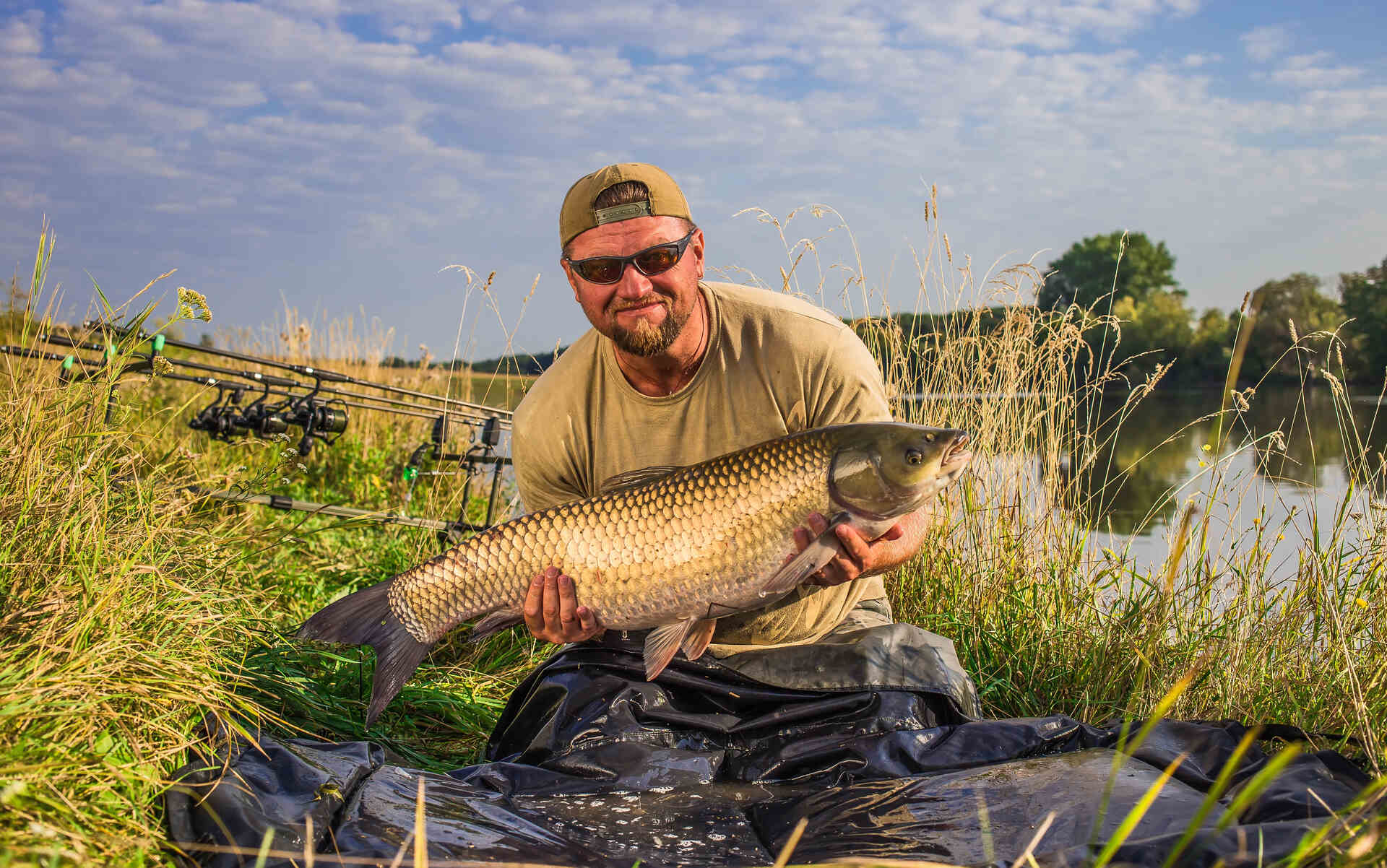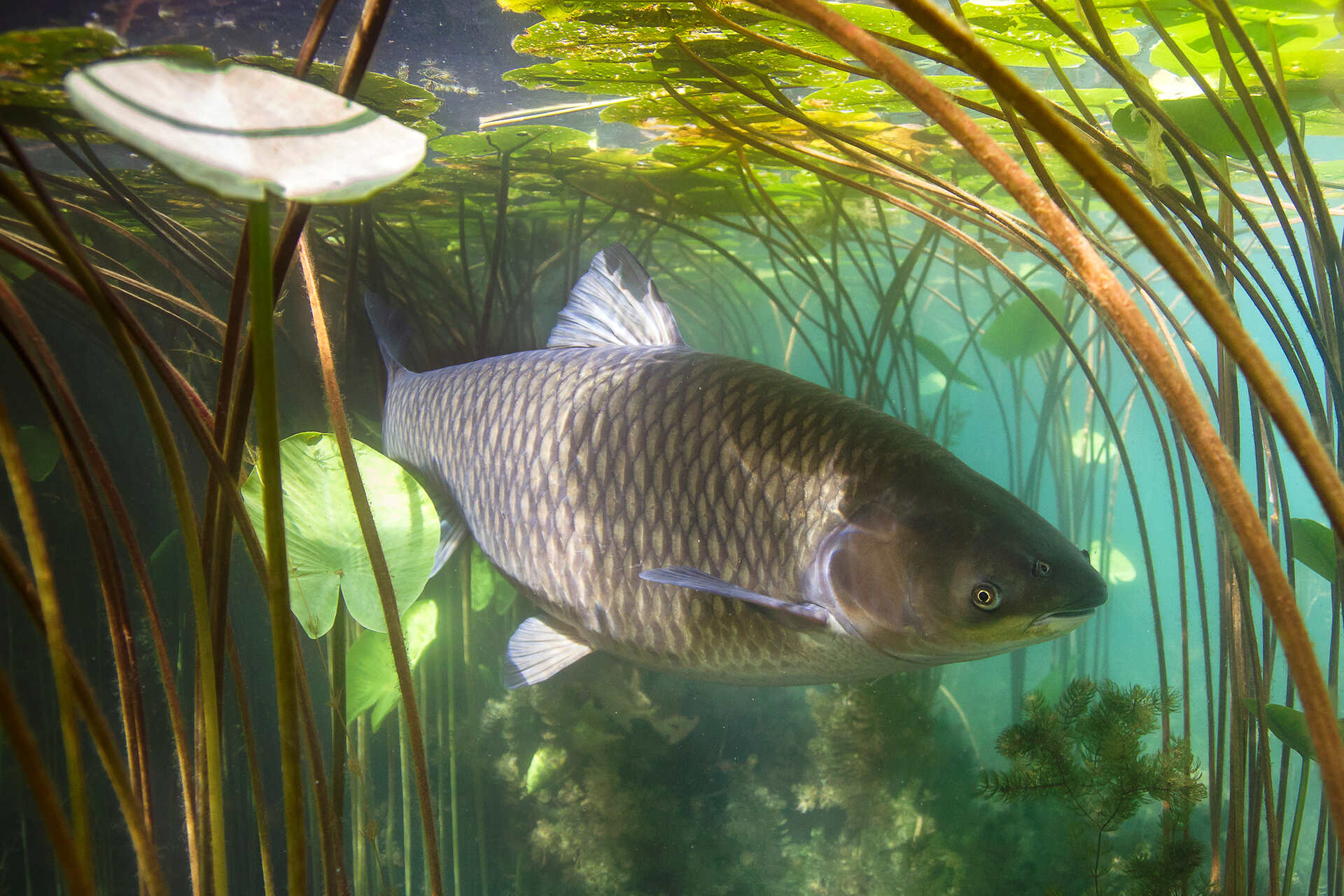Are you looking for a way to expand your fishing repertoire or just hoping for an exciting new challenge? If so, learning how to catch grass carp can be your next exciting endeavor. So, let’s dive into all the tips and tricks for landing these often overlooked beauties – from the bait used to get their attention all the way through hooking and bringing them in.
How to catch a grass carp? Use a medium to heavy rod and reel combo with a strong line. Bottom or surface fishing, as well as chumming, can be effective methods for luring this fish to strike. Once you get a bite, be prepared for a strong fight, as this aquatic beast is known for its strength and stamina.
What Kind of Fish Is a Grass Carp?
Also known as white amur, this fish species presents an exciting challenge for more experienced anglers. Their sheer size, reaching lengths over 3 feet and weighing up to 80 pounds, makes them formidable opponents, especially for beginner fishermen. That’s why successfully landing one of these fascinating creatures feels like a particularly rewarding achievement, leaving you with a sense of accomplishment and awe.
The Impressive Size Is Not the Only Distinct Feature of This Fascinating Fish
White amur possesses a long, cylindrical body with a slightly compressed shape. The coloration varies, but they typically have a dark olive-green or bronze-colored back that fades to a lighter shade on their sides and belly. Their scales are large and rough, giving them a unique texture.
One of the most notable features of this impressive species is its mouth, which is set low on the head and lacks any visible teeth. Instead, they have strong pharyngeal teeth in the throat region, which they use to grind and chew vegetation in their freshwater habitats.
They Prefer Areas With Lots of Aquatic Vegetation
While strong and powerful fish are usually found in saltwater environments, this is a primarily freshwater species, usually found in environments such as lakes, ponds, reservoirs, and slow-moving rivers. They are known to inhabit both shallow and deep waters, but they tend to prefer areas with moderate depths and slower currents.
What sets grass carp apart is their affinity for areas abundant in aquatic vegetation, as they are herbivorous, meaning they feed on various types of aquatic plants. Besides being a food source, dense vegetation also offers them protection from predators and serves as spawning grounds.
This Species Often Displays Schooling Behavior
This species usually displays schooling behavior, congregating in groups near areas with abundant vegetation. They are diurnal feeders, actively foraging during daylight hours, so that you will only be somewhat successful at nighttime fishing for this creature.
In terms of migrational patterns, white amur can undertake the next seasonal movements in search of suitable habitats and food sources:
- Spring – they move to shallow areas to spawn and seek out suitable grounds in areas with aquatic vegetation and slower currents,
- Summer – they tend to remain in their preferred habitats, actively feeding in both shallow and deeper water,
- Fall – they may exhibit some movement as they search for food sources before winter sets in, transitioning to deeper areas as water temperatures cool down,
- Winter – they generally become less active and tend to congregate in deeper areas with more stable water temperatures, exhibiting a slower metabolism and reduced feeding activity.

What Kind of Equipment and Tackle Do You Need for Grass Carp Fishing?
From the fishing rod all the way to the fish hook, having the right gear is crucial when it comes to any angling technique. It’s especially important when dealing with powerful fish such as the white amur, which is capable of putting up quite a fight. Luckily, there’s plenty of sturdy and reliable fishing equipment available on today’s market.
Best Gear for Grass Carp Fishing
Opting for a medium or heavy fishing rod with fast action and a length of around 7 to 8 feet is ideal for handling the size and strength of this aquatic beast. Pairing it with a sturdy spinning or baitcasting reel with a smooth drag system is essential for controlling the powerful runs and surges of these fish.
As for fishing lines, a braided line with a high pound test rating of somewhere between 15 to 30 pounds is recommended to withstand the abrasion caused by their rough scales. Depending on the bait, a size 4 to 2/0 fish hook is appropriate when targeting white amur. Consider using circle hooks, as they tend to result in more hookups in the corner of the mouth, making it much easier to remove them from the fish’s mouth.

When Learning How to Catch Grass Carp Consider Bait Selection
Because these herbivorous fish have specific feeding preferences, using the right bait for grass carp is crucial when targeting this species. Choosing vegetation-based bait is the best way to attract their attention and entice them to bite, and it’s important to present this bait in a natural and appealing manner.
What Are the Most Effective Baits for Attracting Grass Carp?
Here are the best baits for grass carp fishing:
| Type of Bait | Fishing Technique | Description |
|---|---|---|
| Lettuce | Freelining | Fresh lettuce leaves mimic a natural food source |
| Cabbage | Slip bobber rig | Cabbage chunks float near the surface |
| Bread Dough | Bottom rig | Soft, doughy bait that can be molded onto a hook |
| Sweet Corn | Hair rig | Canned or cooked corn kernels threaded on a hair rig |
| Watermelon | Chumming | Chunks of watermelon tossed in the water as chums |
Can You Use Any Natural Baits?
As you can see from the table above, using natural baits for white amur can be highly effective in enticing them to bite. Fresh lettuce leaves, cabbage chunks, and even watermelon can be used as natural, homemade bait. Additionally, learning how to catch grass carp with bread can be particularly rewarding, as it’s pretty alluring for this species.

What Kind of Grass Carp Fishing Techniques Can You Use?
No matter what fishing style you’d like to employ, using sustainable practices is very important for ensuring the long-term health and viability of this species and its natural habitat. Adhering to local regulations and having the right fishing license helps prevent overfishing and allows these fascinating creatures to thrive.
While taking that into consideration, here’s how to catch a grass carp:
Bottom Fishing
One of the proven methods for catching grass carp is bottom fishing, which involves attaching a weight to the mainline, followed by a leader and hook. For this, anglers typically use a bottom rig setup, as the weight ensures that the natural bait sinks to the bottom where white amur often forages.
It’s important to cast the baited rig to areas where this species is likely to be feeding, such as near submerged vegetation or along the edges of aquatic plants. Once the rig is in position, you should wait patiently for the distinctive tug on the line, indicating that the fish has taken a bite.
Surface Fishing
If you’re wondering how to catch grass carp in a pond, surface fishing is one of the most effective methods. Surface fishing for this species can be an exhilarating and visually captivating approach, using techniques such as freelining or float fishing. Instead of sinking the bait, it’s presented on or near the surface to entice white amur that is feeding close to the top of the water. Baits such as floating bread, dog biscuits, or even floating pellets are commonly used.
Using this method, anglers carefully cast the baited rig near floating vegetation or along the edges of lily pads. Watching the water come alive as your target rises to take the bait can truly be an exciting and memorable experience.
Chumming
Chumming for white amur can be an effective strategy, as it involves dispersing small pieces or chunks of bait, such as watermelon, corn, or bread, into the water to create a feeding frenzy. The scent and visual stimulus of the chum draw this species to the area, increasing their activity and making them more receptive to taking a bite.
By enticing grass carp to gather and feed, chumming can create an exciting and action-packed fishing experience, and it’s easy to get carried away. That’s why it’s important to employ this technique in moderation, using environmentally friendly and biodegradable baits and adhering to local fishing regulations.
Figure Out What Are Grass Carp Hotspots
Finding the best grass carp fishing spots requires some research and observation. Local fishing reports, online forums, or your fellow fishermen can provide valuable insight into their potential locations. Once you’ve identified these areas, it’s vital to look for signs of abundant aquatic vegetation.
Visually scanning the water’s surface for signs of activity, such as rolling or splashing, can also indicate their presence. Additionally, using polarized sunglasses can help spot these fish cruising near the surface or feeding among vegetation.
Take Feeding Patterns Into Consideration
Probably the most helpful aspect in locating hotspots is taking the carp’s feeding patterns into consideration. As already mentioned, they are diurnal feeders, meaning they primarily feed during daylight hours. Early morning and late afternoon tend to be particularly productive as they are usually more active during these periods.
By aligning your fishing efforts with the natural feeding patterns of this species, you will not only be able to locate them and make the most of your time on the water, but you’ll also be able to figure out the right bait selection and presentation. There’s always a healthy dose of trial and error with these efforts, but once you get the hang of it, it’ll be a particularly rewarding experience.
Follow My Guide and You’ll Surely Catch Grass Carp
Now that you know everything about grass carp, how to catch them, and what is the most efficient bait to use, it’s time to get out there and try out your luck on the water. So, gather the strongest equipment you can, make some homemade natural bait, and set out on your journey. With these tips and tricks, you’ll surely have a bountiful experience, maybe even setting a personal record. Good luck!







